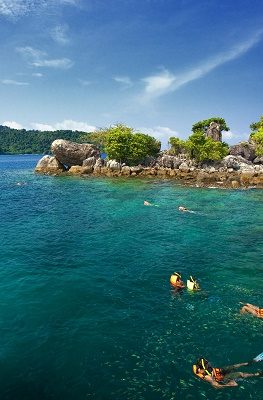Published on August 28, 2017

Divers off Sipadan, Malaysia. Image courtesy of Tourism Malaysia.
Travel blogger David Hogan has traveled across Southeast Asia and the world, mostly above the water but sometimes plunging to the depths.
Southeast Asia, after all, is home – David is a proud Malaysian (his blog, Malaysia Asia, deals largely with his travels around his home country) – and his enthusiasm for the region extends to putting on scuba gear and getting acquainted with mantas, whale sharks and nudibranches skittering between the corals.
We asked David to tell us about his favorite dive spots in the region: he had plenty of glowing things to say about a few areas, some of which will surprise you!
SIPADAN, MALAYSIA – “Diversified, Overall Experience”
“If you ask me which is my most preferred, I still say Mabul Island and Sipadan, off the east coast of Sabah,” David begins. “They’re my favorite due to the diversified overall experience – you can get to see the small stuff, you get to see good landscape, and you get to see big stuff.”
The Malaysian government knows it has a good thing worth protecting, so they’ve instituted a system that allows only 120 dive permits to be issued every day to Sipadan, with dives tolerated only between 8am and 3pm. Get past these roadblocks, though, and you’ll find yourself amidst some of the finest sights below the sea, with something for almost everyone.
“Macro divers dive around Mabul [where] the dive sites are only about three to five minutes away from your guest house or resort,” David explains. “It’s very, very practical; in less than 10 minutes you can be at a good dive site.”
David says there’s “a bit of everything” for leisure divers, with varied terrain and wildlife depending on where you go. The waters around Mabul and Sipadan feature over 3,000 fish species and 300 hard and soft coral species, drawing bigger creatures like whale sharks, hammerheads, barracuda, and sea turtles to feed and breed.
The pass system doesn’t apply to the dive sites around Mabul Island, but David suggests finding a way to finagle a pass to Sipadan anyway. “If you come all the way to Mabul, you have to dive Sipadan!” David laughs. “[Leaving it out is] like going to Yogyakarta and you don’t go to Borobudur!”
- Read about the underwater treasures of Sipadan Island.

Purple fishes at Tatawa Besar, Komodo National Park, Indonesia. Yuxuan Wang/Creative Commons
KOMODO, INDONESIA – “Two Birds with One Stone”
Flores’ Komodo dragons understandably get top billing, but David thinks the lizards are only half the fun of visiting their namesake national park in East Nusa Tenggara, Indonesia.
“The thrill about Komodo is that you kill two birds with one stone,” David explains. “You dive in Komodo, you can also see the Komodo dragon. Packages are being sold that way.”
It’s not a bad way to spend three to four days around Flores – David says the Komodo dragon meet-and-greet takes up just a half-day, “the rest of the package is just dive, dive, dive, dive.”
In Komodo’s depths, divers will find one of the most unspoiled underwater territories in Indonesia, with over 380 species of coral, 70 species of sponge, 10 types of dolphin and an almost endless assortment of fish, sharks and stingrays waiting for them.
“Komodo is more exotic – it just came out in the tourism market in the last three to four years,” David explains. “The dive sites are relatively new, you get to see big stuff – you can see mantas during manta season, there’s a dive spot where you’re guaranteed to see a manta.”
Divers can hire from a great many dive centers based in Labuan Bajo, the biggest city on Flores’ west coast. “You can just walk up to them, and go shopping for the best deal,” David tells us. “The hardcore divers, they will book a liveaboard; Komodo has a lot of them.”
- Read about nature-based tourism in Indonesia.

Anilao, Philippines. Image courtesy of Teabag Allen/Creative Commons.
ANILAO, PHILIPPINES – “Macro Haven”
This sleepy locale – just three hours’ drive south from the Philippines’ capital Manila – seems strangely untouched by civilization, considering that Filipinos have been scuba-diving in its waters since the 1960s.
“It’s not an easy place to go to,” David explains. “[It’s just a] bus ride there from Manila – when you get there, it’s not super touristy, really, you dive and that’s it.”
Good thing there’s so much going on under the water’s surface, then. “Anilao is a macro haven – all you want to see in the macro world can be seen here,” David tells us, explaining that his photographer friends had clued him in on the area’s riches.
“Anilao was one of the hotspots for macro photography – everyone wanted to photograph the rare stuff, [post on] social media.” The proliferation of gorgeous underwater photography shot in Anilao created a ratchet effect: “The next thing you know, everyone wants to go to Anilao!”
- Read more about soft adventure in the Philippines.
* * * *
To check out David’s other adventures (both above and under water), read his blog Malaysia Asia, or follow him on social media: Facebook, Twitter and Instagram






